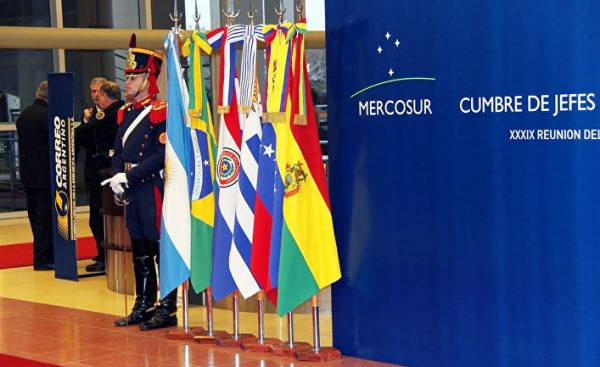
Beginning of 2017 was marked by two events: the election trump US President and a British exit from the European Union (Pexit). No doubt, these two events will have an impact on the world order, both political and economic spheres.
In 2015, U.S. GDP is more than three times higher than the GDP of all countries in Latin America and the Caribbean. On UK GDP accounts for a fifth of the total GDP of the EU.
The changed political situation in the US and the UK will undoubtedly have an impact on the economic development of the Latin American region.
Emerging in 2017, the process of stagnation in the European economy will lead to reduction of the market by about 20%. Against this background, in the US there is the strengthening of the dollar and increased production.
In Latin America there is a strengthening of dependence on external trade. The South American country pereorientirovanija on China. The Caribbean countries are strengthening their relations with the United States.
A special place is Venezuela, which is experiencing a deep political and economic crisis. Looks strange the situation when the country has virtually stopped the inflow of foreign investment, and Caracas is investing in the American economy. It is through the Venezuelan state oil company PDVSA, which became the owner of American energy company Citgo. This company is engaged in oil refining, and transportation and marketing of petroleum products, it owns 48 terminals in 20 States of the USA.
Venezuela is moving closer to China and Russia. Taking their loans, the country falls into financial dependence, which is fraught with aggravation of the situation in the Caribbean, including an armed confrontation. The impossibility of payment for obligations of the company PDVSA, creating real conditions for its bankruptcy.
Not coincidentally, Colombia has expressed its desire to become a NATO member.
South America in the North Atlantic Alliance?
You need to take seriously the words of Barack Obama when he was President of the United States and said that Venezuela is a threat to the United States. In this case, Cuba is in a very difficult situation on the background of recent threats trump to reconsider relations with Havana.
The future of economic development in Latin America will depend on the willingness of countries in the region to go for structural reforms to reduce trade, financial and industrial dependence on external market.
Since the 90-ies of the last century, drastic changes have occurred in global trade in connection with the international division of labour and the growth of economic power of Asian countries, primarily China.
The economic slowdown in the United States and taken by the White house protectionist measures in trade, and a British exit from the European Union negatively affected the economies of Latin America. They remain focused on selling raw resources abroad and the purchase of industrial goods in developed countries.
With the exception of Mexico, Brazil and Argentina. Mexico supplies cheap labor in the United States. Brazil and Argentina after the Second world war were able to create a production base and to provide import substitution, and through the creation of the southern common market (MERCOSUR) to expand exports of goods and services to neighboring countries.
Dynamics of development
The difference of economic development of the countries of Latin America due not only to the extent of their participation in the international division of labor, but also the spatial heterogeneity. Brazil, Mexico and Argentina accounted for 70% of GDP in Latin America.
This situation led to the fact that the more developed Latin American countries have a serious impact on their neighbors. Mexico is heavily dependent on the US, at the same time it has an impact on the countries of Central America. The situation is similar with Brazil, whose economy is closely linked with the countries of South America.
It should be noted that the difference is evident not only in GDP but also in terms of economic growth. Over the past five years, economic growth in Panama, Bolivia, Nicaragua and the Dominican Republic amounted to 5%. In Paraguay, Peru and Colombia — 4%. In Mexico, Brazil and Argentina to 2.8%, 1.4% and 1.0%, respectively.
The industrial capacity of Mexico focused on the American market. Dependence on its Northern neighbor led to the fact that Mexico has lost almost trade and economic relations with the countries of Central and South America.
Trade relations in Latin America are based on three multilateral trade agreements: North American free trade agreement (1994), free trade agreement between the Dominican Republic and Central America (2006), the southern common market (1991). Mexico exports to United States 81% of its production, Brazil -12%, Argentina — 5%.
China shows a steady growth of investment in South American countries and increase imports from the region. After starting the U.S. withdrawal from the agreement on the TRANS-Pacific partnership, Beijing successfully takes the place of the United States.
The white house is currently engaged in negotiations on the renegotiation of the North American free trade agreement. First of all it concerns the revision of the exchange rate, which the White house wants to freeze and dollarization of the economy of the countries members of the Pacific Alliance.
Now the dollar is in free circulation in Ecuador, El Salvador and Panama.
It is necessary to remind that the idea of dollarization was first proposed by U.S. Secretary of state James Blake in 1889 and further discussed at a conference on monetary policy in 1891.
The administration of the trump is also planning to revise the previously signed agreements with other countries relating to intellectual property, patenting inventions. Against Mexico, the United States is seeking to reduce exports of refined sugar and at the same time to increase the supply of unrefined raw materials. It is possible that the Mexican government will agree to this proposal in exchange for the softening of Washington’s position on migration.
To date, the USA has bilateral free trade agreements with Chile (2004), Peru (2007), Panama (2007), Colombia (2007), Central America and the Dominican Republic.
Duma about the region
It should be noted that a negative impact on the future economic development of Latin America impose a deterioration of the political situation, democratization and handling. We are witnessing the economic crisis and the departure from the political arena progressive governments (Argentina, Venezuela, Ecuador, Bolivia, Uruguay, Brazil), which leads to the curtailment of regional ties and trade cooperation. In the case of Venezuela — very bad things. Due to the fall in oil prices, the country was on the brink of financial bankruptcy.
Regardless of the political orientation of the authorities, rejection of national interests in all Latin American countries have seen the growth of corruption of officials at all levels and their desire to get to the subordination of transnational companies.
An example is the outbreak of a corruption scandal surrounding the Brazilian engineering company Odebrech, which sent politicians and businessmen more than three billion dollars in bribes in the period from 2005 to 2014.
Probably, with the exception of Peru, where former President Fujimori was behind bars, in no other country in Latin America vysokopostavlennye officials have not been punished for the crimes committed.
From Latin America do not have much of a choice to stop the further advancement of American hegemony and China’s economic expansion. It is necessary, first, to restructure financial and trade spheres, and secondly, to overcome the political crisis, to reduce social inequality and concentration of capital in the hands of the ruling elite. These are not easy tasks. For their implementation will require the combined efforts of all branches of government, political forces and public organizations.
The IMF forecasts regarding the growth of GDP in Latin America is disappointing. According to his forecasts, in 2017 the GDP in Latin American countries will increase by 2%. While in Mexico and Brazil it will be 1.7% and 0.2%. In Central America and 3.9%, Panama is 5.8%.
New opportunities for Latin America is opened in connection with the expansion of economic cooperation southern common market with China and the European Union. The weakening of the US trade and Latin America should bet on search for new trading partners.
Latin American countries should abandon export commodity of the economy and move to an innovation economy more competitive, based on intellectual resources.







